Platform Integration: Getting started with LPCXpresso54608
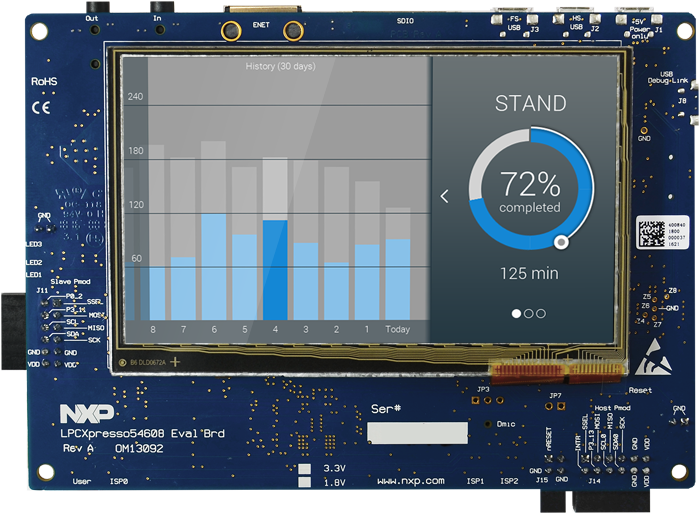
LPCXpresso54608 development board.
The following article explains all necessary steps to create an Embedded Wizard UI application suitable for the LPCXpresso54608 development board. Please follow these instructions carefully and step by step in order to ensure that you will get everything up and running on your target. Moreover, this article assumes, that you are familiar with the basic concepts of Embedded Wizard.
Prerequisites
First of all, you need the following hardware components:
★LPCXpresso54608 development board from NXP
★USB cable to connect the board with your PC
Make sure that you have got the following software packages:
★Embedded Wizard Studio (Evaluation Edition, Starter Edition or Professional Edition)
★Embedded Wizard NxpLpc Platform Package
TIP
If you want to use the Evaluation Edition of Embedded Wizard Studio and the NxpLpc Platform Package, please register on our website and select the target LPCXpresso54608. Then you can download the above software packages.
Installing Tools and Software
★Step 1: Install the latest version of Embedded Wizard Studio.
★Step 2: Install the Embedded Wizard NxpLpc Platform Package.
★Step 3: Visit the NXP website and build/download the MCUXpresso Software Development Kit (SDK) for LPCXpresso54608. Write down the installation path.
★Step 4: Download the MCUXpresso Integrated Development Environment (IDE) from NXP and install it. Write down the installation path.
★Step 5: Connect your development board with your PC via USB (make sure to use the USB Debug Link connector) and remove jumper JP5 from the board. Otherwise flashing your software is not possible.
★Step 6: Create your NxpLpc project directory (e.g. \NxpLpc) at any location in your local file system (e.g. in {UserDocumentFolder}).
★Step 7: Download the latest version of the Embedded Wizard Build Environment for LPCXpresso54608 and unpack it into the subdirectory {UserDocumentFolder}\NxpLpc\LPCXpresso54608
★Step 8: Take a text editor and open the file devenv.cmd that you will find in the directory {UserDocumentFolder}\NxpLpc\LPCXpresso54608\Build. Set the path of your installed MCUXpresso SDK (Step 3) to the environment variable SDK_PATH and set the path of your installed MCUXpresso IDE (Step 4) to the environment variable MCUXpressoIDE_PATH.
Exploring the Build Environment
The provided Embedded Wizard build environment for LPCXpresso54608 contains everything you need to create, compile, link and flash an Embedded Wizard UI application for the LPCXpresso54608 target. After unpacking, you will find the following subdirectories and files:
•\BoardConfig - This folder contains all configuration files and platform specific source codes.
•\Build - This folder contains the necessary stuff to build your UI application: the make utility and the script file StartBuildEnvironment.bat to start a windows command line to build the application. Don't forget to set the path of your installed MCUXpresso toolchain into the file devenv.cmd.
•\Examples - This folder contains a set of demo applications. Each example is stored in a separate folder and contains an Embedded Wizard UI project, the necessary source code (e.g. main.c) and the necessary makefile to build the demos. Every Embedded Wizard project contains already the necessary profile settings for the LPCXpresso54608 target. The following samples are provided:
•\HelloWorld - A very simple project that is useful as starting point and to verify that the entire toolchain, your installation and your board is properly working. The subdirectory \EmWiProject contains the Embedded Wizard project file.
•\ColorFormats - This project demonstrates that every UI application can be generated for different color formats: RGBA8888, RGB565, Index8 and LumA44.
•\ScreenOrientation - This demo shows, that the orientation of the UI application is independent from the physical orientation of the display.
•\DeviceIntegration - This example shows the integration of devices into a UI application and addresses typical questions: How to start a certain action on the target? How to get data from a device?
•\Template - This is just a template to build your own UI applications. It contains a main.c file and a makefile. You can create your own UI project and generate the code into the subdirectory \GeneratedCode.
•\Misc - This folder contains some helper modules for printing debug messages and the memory manager used for the Embedded Wizard UI applications.
•\PlatformPackage - This folder contains the necessary source codes and/or libraries of the NxpLpc Platform Package: Several Graphics Engines for the different color formats (RGBA8888, RGB565, Index8 and LumA44) and the Runtime Environment (in the subdirectory \RTE).
Creating the UI Examples
For the first bring up of your system, we recommend to use the example 'HelloWorld':
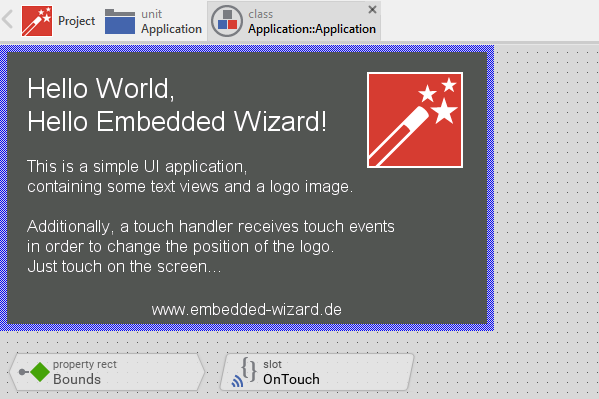
Example 'HelloWorld' within Embedded Wizard Studio.
The following steps are necessary to generate the source code of this sample application:
★Navigate to the directory \Example\HelloWorld\EmWiProject.
★Open the project file HelloWorld.ewp with your previously installed Embedded Wizard Studio. The entire project is well documented inline. You can run the UI application within the Prototyper by pressing Ctrl+F5.
★To start the code generator, select the menu items - or simply press F8. Embedded Wizard Studio generates now the sources files of the example project into the subdirectory \NxpLpc.
Compiling, Linking and Flashing
The following steps are necessary to build and flash the Embedded Wizard UI sample application:
★Navigate to the directory \Build.
★Open StartBuildEnvironment.bat - as a result, a windows command line window should open. The starting directory location is \Examples.
★Navigate to the subdirectory \HelloWorld and start compiling, linking and flashing:
cd HelloWorld make make install
If everything works as expected, the application should be built and flashed to the LPCXpresso54608 target.
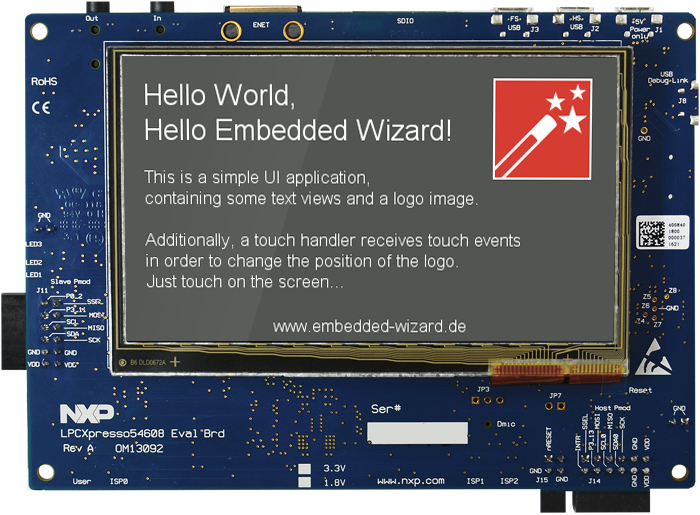
Example 'HelloWorld' running on LPCXpresso54608 development board.
All other examples can be created in a similar manner. Please follow the instructions of the ReadMe.txt files that are located within every example.
Creating your own UI Applications
In order to create your own UI project suitable for the LPCXpresso54608 target, you can create a new project and select the LPCXpresso54608 project template:

As a result you get a new Embedded Wizard project, that contains the necessary Profile attributes suitable for the LPCXpresso54608 development board:
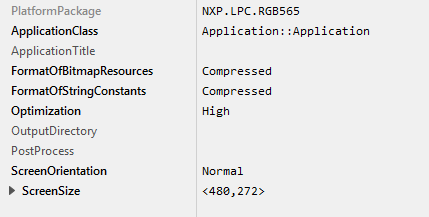
The following profile settings are important for your target:
★The attribute PlatformPackage should refer to an installed NxpLpc Platform Package.
★The attribute ScreenSize should correspond to the display size of the LPCXpresso54608 development board.
★The attributes FormatOfBitmapResources and FormatOfStringConstants can be set to DirectAccess in case that the resources should be taken directly from flash memory. By default these attributes are set to Compressed.
★The attribute OutputDirectory should refer to the \Examples\Template\GeneratedCode directory within your Build Environment. By using this template, it will be very easy to build the UI project for your target.
Working with the Template
If you want to compile and link your own UI application, you can use the provided template (\Examples\Template) to build the application. This template is prepared to compile any UI application that is generated into the subdirectory \GeneratedCode.
After generating code, please follow these steps, in order to build your own UI application:
★Start the batch file 'StartBuildEnvironment.bat'. Again, a windows command line window should open. The starting directory location is \Examples.
★Navigate to the subdirectory \Template and start compiling, linking and flashing:
cd Template make make install
This template can be configured easily according your needs by changing the provided flags within the Makefile. These are the most important system settings that can be adapted:
•Color format of the framebuffer
•Color format of the Graphics Engine (which has to correspond to the color format of the PlatformPackage used within your UI project)
•Usage of screen rotation (which has to correspond to the ScreenOrientation used within your UI project)
•Usage of QSPI flash memory
Console output
In order to receive error messages or to display simple debug or trace messages from your Embedded Wizard UI application, a serial terminal like 'Putty' or 'TeraTerm' should be used.
★As soon as you connect your LPCXpresso54608 target with the PC via USB, a LPC-LinkII UCom Port (COMx) appears within your system device list. Open the device manager to get the number of the installed COM port.
★Now you can open your terminal application and connect it via COMx with the following settings: 115200-8-N-1
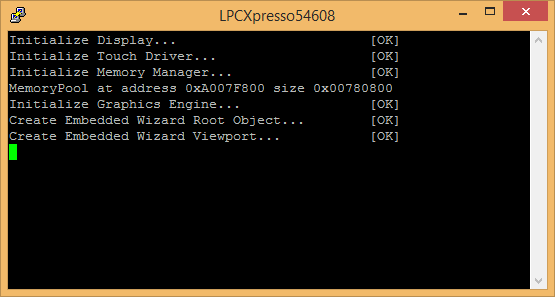
This terminal connection can be used for all trace statements from your Embedded Wizard UI applications or for all debug messages from your C code.
